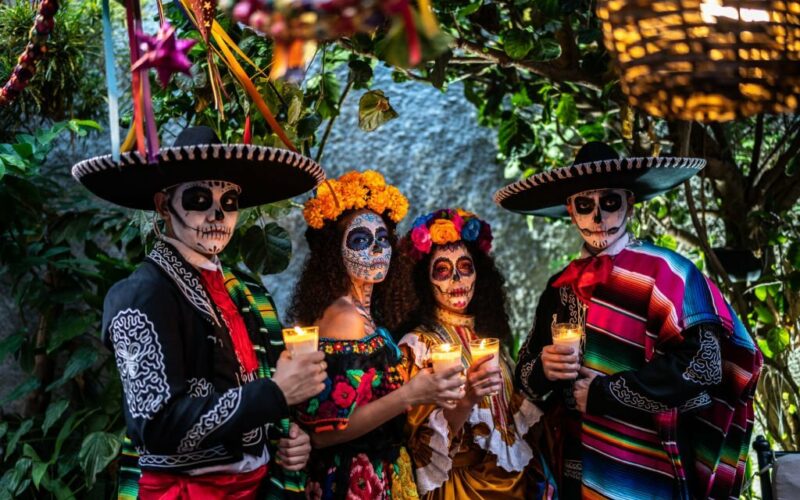Countries That Still Wear Their Traditional Clothes: In the past, every country, tribe, and town had its own unique style of traditional clothes. Many of these clothes are still worn today, but not as often as they once were.
According to Black Rooster, in Oklahoma, Choctaw women still make beautiful traditional dresses and shirts from colorful cotton cloth edged in fine ribbon work. This dress is the product of a long line of adaptations from Euro-American styles, but it still has many Choctaw traditions.
-
Table of Contents
Bhutan
Bhutan is an ancient country that has remained non-commercial, strongly emphasizing Buddhism and tradition. This is reflected in the way that they still wear their traditional clothes.
Men in Bhutan wear long robes called “gho,” which are usually brightly colored and made from wool or cotton. These can be folded up when not in use and are also useful for keeping warm during cold weather conditions.
Women in Bhutan wear ankle-length dresses known as “kira.” Kiras are firmly fastened at the shoulders with either simple pins or complicated silver brooches. They are traditionally handwoven and have intricate designs, but they can be machine-made from cotton and other fabrics these days.
A short coat-like garment is sometimes worn with kiras to spruce them up. A light-colored coat called a “toego” is also common and can be found in various colors, patterns, and styles.
The most popular Bhutanese textiles are hand-woven on back strap looms like those used centuries ago, but modern threads and synthetic fabrics are making inroads into the textile market. Among the best are the silks woven in Lhuentse villages by Kurtoep women, who have been weaving in this area for generations.
Despite these advances, Bhutan’s edicts require that all people wear traditional clothing publicly. Those who do not follow these laws can face stiff fines or jail terms. Luckily, many Bhutanese are proud to keep their traditions alive and happy to wear their traditional clothes in their everyday life.
-
Sami
Sami are people who still wear their traditional clothes, often called gakti. These are brightly colored outfits that are worn at parties, festivals, weddings, baptisms, and funerals. The design of the gakti includes many symbols, and each little feature has its own meaning.
The Sami are indigenous to northern Norway, Sweden, and Finland. They also inhabit the Kola peninsula in Russia. They are known for their reindeer herding, fishing, and traditional religion.
There are eleven languages and dialects spoken by the Sami. The area in Norway where the Sami live is called Sapmi, and it extends into parts of Sweden and Finland as well.
Traditionally, the Sami lived as nomads, traveling from one place to another throughout the year. They built lavvu tents and turf huts for their accommodation, but modern housing is now available to all.
Their traditional outfits – often called kolt or gakti – show their pride in their heritage and geographical origin. They have at least twelve different styles, and a few have been redesigned for the contemporary world.
Their traditional culture is now recognized and supported by the governments of Norway, Sweden, and Finland. The three countries have grant programs to promote and preserve Sami culture. In addition, daily radio and television shows are broadcast in the Sami language.
-
Mongolia
The landlocked country of Mongolia is a vast region that is home to 2.8 million people. It covers an area of 1,564,116 square kilometers and borders Russia to the north and China to the south. Amazing Australia Experiences for Every Type of Traveler
Despite modernization, many of the old conventions of Mongolian life have survived and continue to be practiced. These include traditional gers (circular tents with beds and chimney heating) that are pitched with the door facing south, as well as the west side of the ger is considered the man’s domain, where his saddle, tack, and skin bag of koumiss or airag are kept.
Another important feature of Mongolian culture is the national costume, the deel. This long gown is buttoned up to the neck on the right side and has a sash of contrasting color around the waist, which both men and women can wear.
It is a simple dress that can be easily altered to fit the wearer’s body shape. Each ethnic group living in Mongolia has their own unique deel, which is distinguished by its cut and color.
The deel is a central part of the traditional outfit, worn by men and women during official ceremonies and everyday activities. During festivals, men also wear a sash of a contrasting color over their deal, while married Chahar women wear a waistcoat over their deel.
-
Tahiti
Tahiti, an island group in the Pacific, was first settled by migrating Polynesians as early as 500 BC. European explorers later discovered it, and it became the center of French colonization during the 16th century. Today, it is an autonomous overseas country of the French Republic.
A large part of Tahiti’s culture is still preserved in its traditions. These include a rich and vibrant Polynesian heritage that includes weaving, woodcarving, and tattooing. Each tradition tells a beautiful story about life and love in Polynesian society.
Another significant cultural tradition in Tahiti is dance. During the 19th century, the British banned Tahitian dancing, and it was not revived until Madeleine Moua, a French-Tahitian dancer, brought back the ancient art form.
The ote’a is one of the most famous Tahitian dances. It is performed by a group of women dressed in a pareo and maro. This style of dance is slow and sensual and has a classic story that it tells.
More Western influence has been introduced to the Tahitian people in recent years. This has changed the way they live and has also influenced how they dress.
The traditional food of Tahiti is fresh seafood and tropical fruits. It is widely available and delicious. A popular dish is sashimi, which consists of thinly sliced raw fish or meat served with soy sauce.
-
Maya
The ancient Mayans were well-known for their exotic appearances and unusual body modifications. They exploited the resources they had available to them in their tropical environments to make a wide range of colorful textiles and striking ornamentation.
Men and women wore a variety of headdresses. They could be as simple as a skull cap or elaborate as a carved animal head. The type of headdress a person wore reflected their status in the community. For example, ballplayers and warriors wore headdresses resembling the animals they played the game with.
In everyday life, Maya farmers wore minimal clothing. They wore either a loincloth or a band of cloth tied around their waists and sometimes a moccasin made from deer hide.
While these basic clothes were not the most luxurious, they incorporated all the basic elements of Maya dress for both genders. For women, these included a huipil, a wraparound skirt, and faja, which was a woven belt that tied both the huipil and the skirt together to form a traje.
In the Hindu tradition, the gods Shiva and Vishnu were considered to be the avatars of Maya. According to the rishis, Maya consists of two polar aspects: avidya, which leads human beings away from the divine, and vidya, which leads to the realization of the divine. In both cases, it is essential to cultivate virtuous spirituality to escape Maya’s grip.
-
China
China has a long history of clothing, with each dynasty nurturing its own traditions. Its 56 ethnic minority groups also have their own clothing styles.
In today’s China, traditional Chinese dress has become a part of daily life for many Chinese people. This has helped to keep the country’s culture alive and has encouraged a revival of traditional Chinese clothes.
Traditional Chinese clothing usually adopts a straight cut and loose shape. They are also comfortable to wear and can fit a variety of body shapes. They are light-colored and can range from white to red, yellow, and purple.
They have been around for thousands of years and are compatible with other clothing traditions in the world. They are also compatible with Chinese philosophies, which value order, etiquette, and high moral standards.
The most common type of traditional Chinese dress is the qipao. It is a loose dress that was created during the Manchu period and is still worn by women today.
Another popular type of traditional Chinese dress is the cheongsam. This dress is a one-piece dress that is often made of red silk and is embroidered with intricate gold and silver motifs.
The Dai, an ethnic group living in China, are also well-known for their traditional clothing. This clothing is designed to reflect a mixture of influences from Southeast Asia, including Thailand, Burma, and Laos. This clothing is worn by a diverse community, from history enthusiasts to students and young professionals.









